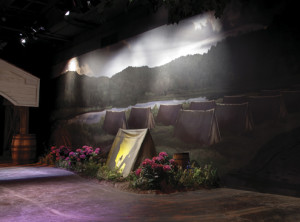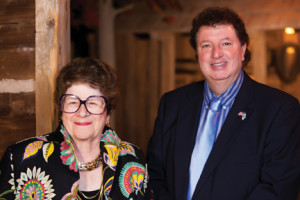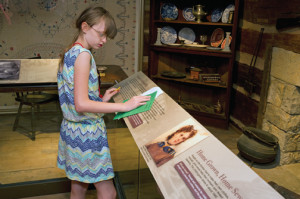The West Virginia State Museum is a local treasure that has been educating residents and visitors alike on the unique history and culture of the Mountain State for more than 100 years.
By Samantha Cart
Nestled in downtown Charleston, the West Virginia State Museum has been dedicated to educating the public through its collection, preservation and exhibition of the state’s history since the early 1900s. With exhibits and artifacts that range from history, culture and art to paleontology, archeology and geology, every region of the state, including the land, the industries and the people, is represented in an effort to instill a sense of pride in both natives and visitors.
 While the museum’s main goal is to educate and conserve the state’s history, daily operations also significantly impact the economy. When the new museum was built in 2008-2009, the state spent around $4 million on construction and design. There is no admission fee to the museum, and no charge is made to student groups for the materials and equipment used during their visits. However, these visits do result in significant revenue for the museum’s gift shop, as student groups spend between $300-400 on average during a visit to the State Capitol Complex and State Museum. “It is our mission to encourage an understanding of the state’s history, culture and heritage with our programming and activities,” says Caryn Gresham, deputy commissioner of the West Virginia Division of History and Culture. “In addition, since taxpayers make a contribution to the museum when they pay taxes each year, we don’t want to charge them again for a visit.”
While the museum’s main goal is to educate and conserve the state’s history, daily operations also significantly impact the economy. When the new museum was built in 2008-2009, the state spent around $4 million on construction and design. There is no admission fee to the museum, and no charge is made to student groups for the materials and equipment used during their visits. However, these visits do result in significant revenue for the museum’s gift shop, as student groups spend between $300-400 on average during a visit to the State Capitol Complex and State Museum. “It is our mission to encourage an understanding of the state’s history, culture and heritage with our programming and activities,” says Caryn Gresham, deputy commissioner of the West Virginia Division of History and Culture. “In addition, since taxpayers make a contribution to the museum when they pay taxes each year, we don’t want to charge them again for a visit.”
In 2014, more than 15,000 students from schools and other groups spanning 45 counties visited the West Virginia State Museum. Museum Education Manager Nancy Herholdt says the Museum Education Unit provides a variety of programs for teachers who bring their students to tour the facility. There are six programming options that represent a wide range of opportunities and can be adapted for groups from kindergarten through high school. Each program has materials for students to use and keep for post-visit work in the classroom. With more than 8,000 participants each year, the most popular program is Media Stories, during which students have access to video cameras and are asked questions about the artifacts and historic information throughout the museum. After the tour, students can download their videos onto flash drives to take back to their classrooms and share.
Total attendance for 2014 topped 70,000, which included individuals, families and tour groups. “The State Museum is a valuable partner to the Charleston travel and tourism industry,” says Gresham. “Indirectly, we support the city and state as a site that visitors enjoy when they are in Charleston. The Culture Center opened the museum and archives to the Travel South USA Media Reception in 2013, which provided us with the opportunity to showcase the museum and resulted in coverage in regional and national travel publications.”
According to Operations Manager Charles Morris, the museum gets visitors from all over the world, not just the Mountain State. “We’ve received visitors from Japan, England, China, Canada, Puerto Rico, Qatar, Germany, Mexico, France, Korea, Austria, Romania, Ireland, Spain, Argentina and almost all 50 states with the possible exception of Hawaii,” he says. “One of the great things about our location is that we often get travelers just passing by on the interstates that see the Capitol building or a sign for the museum and decide to stop. I often have the pleasure of going upstairs to talk to someone traveling through, and they want to tell me how incredible the museum is—some say the best one they have visited—and that we have the most beautiful Capitol anywhere in the United States.”

The museum’s collection was originally part of the West Virginia Historical and Antiquarian Society, housed on the first level of the State Capitol Building. In the early 1970s, experts decided the collection had outgrown its space in the Capitol. The West Virginia Science and Culture Center was opened in 1976 and held the collection for 30 years before renovations were made to modernize the facility. The most recent updates made the museum a truly one-of-a-kind experience for staff and visitors. “The plans for the West Virginia State Museum renovation were on my conference table when I arrived 14 years ago,” says Kay Goodwin, cabinet secretary for the West Virginia Division of Culture and History. “The former State Museum was still in place in the lower level of the Culture Center, with 2,500 artifacts displayed. Some funds had been promised, but there was no cost estimate to the proposed plan. In reviewing the two-foot stack of paper on my conference table, I realized that a more dramatic treatment would be preferable given my theater background.”
Goodwin approached the renovation of the museum like producing a play. She knew in order to make the transition work, she needed to call in the experts. After reaching out to Fairmont native Bob Shreve, former deputy of culture and history commissioner for Norman Fagan, the team was able to move forward in building the State Museum we now know today. “We needed lights, sound, drama and audience participation. As a matter of fact, I coined the term ‘show path’ to document the travel through time from West Virginia’s beginnings to today’s fairs and festivals, art and music and road and interstate travel,” says Goodwin. “Bob had been a Disney Imagineer, designed Universal Studios’ Jurassic Park and worked with Herschend Family Entertainment and Dollywood. As my mentor and inspiration, Bob suggested a colleague of his, Rob Charles, to help during the first steps in designing and costing out a dream state history museum. They brought to the process their experience with a theme park’s hands-on activities and durable exhibits.”
The challenges included fitting the new museum into the same space while presenting more artifacts and dismantling the empty canvas of the old museum. The renovations came to life with the help of the Division of Culture and History staff and state historians who were recruited for identifying the 6,500 artifacts. Thanks to their hard work, visitors can now take a journey through time. The museum timespan includes a trek from a pre-historic coal forest into an early western settlement and present-day West Virginia. Following a chronological and interactive show path, the exhibits use sound and lighting to illustrate pivotal moments and changes in West Virginia’s cultural, industrial and natural histories.
While the renovation made a sizable difference to the museum, the biggest change was the range of topics covered compared to the past, according to Morris. The staff continues to build the collection primarily through the generous donations of individuals with historic artifacts pertaining to the history and culture of West Virginia. Contemporary quilts and art are added to the collection each year through juried exhibitions, which bring in the best artisans in the state. “The generosity of West Virginians is amazing, and the collection includes artifacts of great historic significance that make the museum a true state treasure,” says Morris.
 Morris and other staff members enjoy learning the unique and fascinating backstories associated with many of the treasures highlighted in the museum. One such artifact is a 4,000-pound block of bituminous coal that was donated in 1971 by Appalachian Power Company. In the 1960s, the Bluefield Office of Appalachian Power constructed a glass structure over the block of coal and used it as a reception desk. Other favorites include a crewelwork coverlet made by Sarah Rumsey, daughter of James Rumsey, the inventor of the steamboat; a gown worn by Mary Watson as she served as Queen Silvia the IX at the 1938 Mountain State Forest Festival and an artifact from Fort Lee. When a tornado came through Charleston in the 1890s, it knocked down what was left of Fort Lee, which was built in 1788 by a company of Virginia rangers. In order to preserve the logs of the fort, Dr. John Hale made a table from them, which is now featured in the museum. President of the Historical and Antiquarian Society, Hale was also an inventor, physician, historian, businessman, Civil War soldier and mayor of Charleston.
Morris and other staff members enjoy learning the unique and fascinating backstories associated with many of the treasures highlighted in the museum. One such artifact is a 4,000-pound block of bituminous coal that was donated in 1971 by Appalachian Power Company. In the 1960s, the Bluefield Office of Appalachian Power constructed a glass structure over the block of coal and used it as a reception desk. Other favorites include a crewelwork coverlet made by Sarah Rumsey, daughter of James Rumsey, the inventor of the steamboat; a gown worn by Mary Watson as she served as Queen Silvia the IX at the 1938 Mountain State Forest Festival and an artifact from Fort Lee. When a tornado came through Charleston in the 1890s, it knocked down what was left of Fort Lee, which was built in 1788 by a company of Virginia rangers. In order to preserve the logs of the fort, Dr. John Hale made a table from them, which is now featured in the museum. President of the Historical and Antiquarian Society, Hale was also an inventor, physician, historian, businessman, Civil War soldier and mayor of Charleston.
In 2013, during the celebration of West Virginia’s 150th birthday, the museum unveiled its special sesquicentennial exhibit. The artifacts tell stories about the state’s steel, coal, glass, timber and railroad industries. It also introduces some of the historic figures who were honored during the state’s birthday celebration, such as Nobel Prize winner Pearl Buck; the inventor of the pepperoni roll, Giuseppe Argiro; award-winning composer George Crumb and former Secretary of State Cyrus Vance. The exhibit can be found in the Fairs and Festivals zone of the museum and also showcases the Mountain Boy flat boat, talking pictures modeled after the Harry Potter Theme Park in Orlando, FL, and an animatronic soldier.








